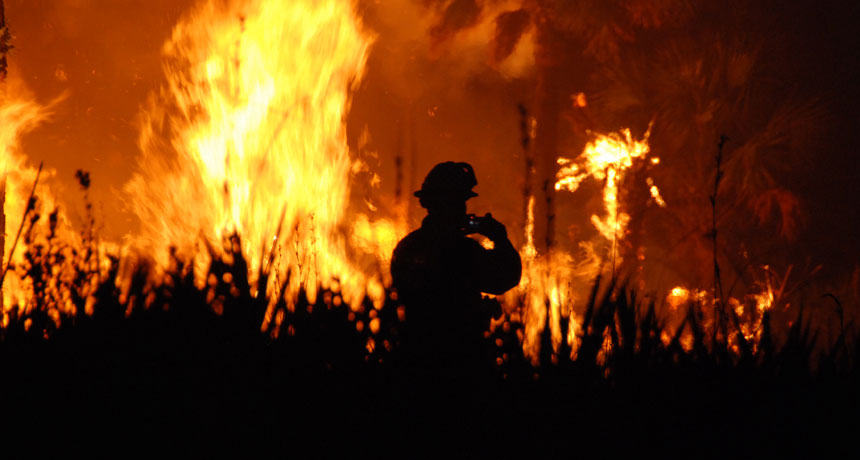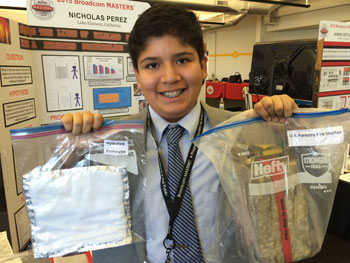Teen invents a better tent to beat fire’s heat
It is a shelter designed to keep firefighters safe

When wildfires get out of control, firefighters can be trapped. A teen has designed a better fire shelter to keep them safe.
U.S Fish and Wildlife Service/Flickr/ (CC BY 2.0)
SAN JOSE, Calif.— Wildfires can be deadly for firefighters. When the flames come too close and escape is impossible, firefighters may need to shelter in place. That’s why they carry portable flame shields with them. They douse these with water and then huddle under them to escape the flames. But right now, these shelters don’t offer enough protection. In 2013, despite such shelters, the Yarnell Hill fire in Arizona claimed the lives of 19 firefighters.
This inspired Nicholas Perez, 13, of St. Edward School in Corona, Calif. Two years ago, he started searching for a material to make a better fire shelter. Now, he’s unveiled his version. All it took him to develop and test it were a few dozen eggs, a lot of foil, an oven and several packs of diapers.
To keep firefighters from burning, Nicholas says, “I knew I had to find something that absorbed and retained water. And I thought ‘wait a minute, diapers do that.’”
When he cut open diapers, Nicholas found small crystals of a chemical called sodium polyacrylate (Pol-ee-AK-rih-layt). When dry it’s a crystal. But when exposed to water, it plumps up into a moist gel that’s many times its original size. By cutting open diapers, he was able to isolate the crystals. In the first year of his project, he demonstrated that these crystals, when made into a gel, formed a fire-resistant shield in a doorway — one that could withstand direct blasts from a blowtorch.
This year, he was determined to take the next step and use those crystals to build a fire shelter. Nicholas showed what he came up with here at a competition known as Broadcom MASTERS (for Math, Applied Science, Technology and Engineering for Rising Stars). Society for Science & the Public (the publisher of Science News for Students and this blog) created the program in 2010. It brings together students with winning middle-school science-fair projects from across the United States. This year, finalists shared their work with each other and the public on October 3 in San Jose, Calif. The MASTERS program is sponsored by Broadcom, a company that builds devices to help computers connect to the Internet.

To test his invention, the teen built a small wooden frame shaped like a box. He placed a single raw egg inside, along with a meat thermometer. It would measure the temperature inside as the outside of the box heated up. Then the young researcher soaked his shelter in water. The crystals absorbed the water, becoming a thick gel. Nicholas then surrounded his boxed egg with this gel-coated cotton blanket and placed the whole thing in an oven at 287° Celsius (550° Fahrenheit). Then, he monitored the temperature next to the egg for 30 minutes.
After the test was done, he took the egg out and cracked it open to see if it had cooked. An egg’s proteins will denature — or lose their structure and become white and solid — at 62 °C (144 °F), so the teen reasoned this egg would make a good stand-in for a firefighter under the same conditions.
In his oven, the official U.S. Forest Service fire shelter heated very quickly. “It reached my thermometer’s maximum capacity of 390 °F [199 °C] after 15 minutes,” Nicholas recalls. “I know even if I was able to keep measuring, the temperature would keep increasing,” he says. Needless to say, the egg inside was completely cooked. But inside the teen’s new fire shelter, the egg stayed comfortable. The air temperature in the box climbed only 11 degrees Fahrenheit. And the egg it sheltered remained “completely raw.”
Nicholas also exposed both his fire blanket and the official fire blanket to direct flames from a blowtorch. While the U.S. Forest Service shelter reached 115 °C (240 °F) when torched, Nicholas’ shelter stayed nice and cool. “It went up zero degrees — and stayed the same the whole test,” he reports.
While he still plans to tweak his shelter’s design, Nicholas is already getting a patent for his invention. “I believe fewer firefighters will die if they use mine,” he says of the new shelter. Soon, he hopes to sell it, and help firefighters beat the heat.
Follow Eureka! Lab on Twitter
Power Words
(for more about Power Words, click here)
conduction One of three major ways that energy is transferred. (The other two are convection and radiation.) In conduction, energy is transferred when atoms and molecules bump into each other, with slower, colder particles gaining energy from the warmer, faster ones that slam into them.
convection The rising and falling of material in a fluid or gas due to uneven temperatures. This process occurs in the outer layers of some stars.
denature A change in the chemistry of proteins that causes them to lose their structure, usually due to stress. Stresses can include heat, acids or bases, solvents and radiation. You can watch proteins denature by cooking an egg (the egg white turns white when albumin denatures) or by making your own cheese.
proteins Compounds made from one or more long chains of amino acids. Proteins are an essential part of all living organisms. They form the basis of living cells, muscle and tissues; they also do the work inside of cells. The hemoglobin in blood and the antibodies that attempt to fight infections are among the better-known, stand-alone proteins.Medicines frequently work by latching onto proteins.
radiate (in physics) To emit energy in the form of waves.
radiation (in physics) One of the three major ways that energy is transferred. (The other two are conduction and convection.) In radiation, electromagnetic waves carry energy from one place to another. Unlike conduction and convection, which need material to help transfer the energy, radiation can transfer energy across empty space.
sodium polyacrylate When dry, this chemical is a crystal. Upon contact with water, however, it quickly swells into a moist gel that can grow to become many hundreds of time its original size. This property quickly gave rise to its popular name: the super slurper. The best known use for this chemical is to soak up urine, creating relatively leak-proof disposable baby diapers.
thermal Of or relating to heat. (in meteorology) A relatively small-scale, rising air current produced when Earth’s surface is heated. Thermals are a common source of low level turbulence for aircraft.